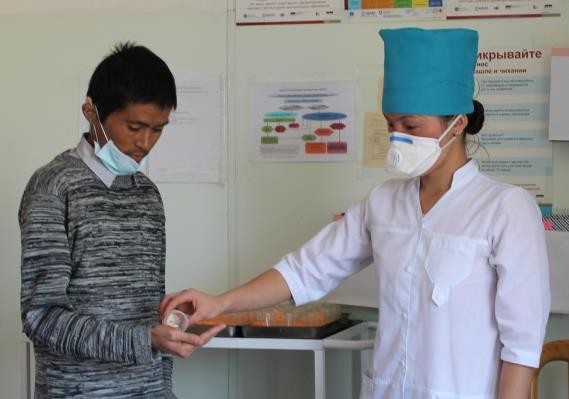
March 2015—Kyrgyzstan has one of the highest rates of tuberculosis (TB) in Europe, with an estimated incidence of 141 cases and 9.5 deaths per 100,000 people. According to the latest data, the prevalence of multidrug-resistant TB (MDR-TB) is now 26 percent among new TB cases, and 68 percent among previously treated cases.
With MDR-TB a growing problem nationwide, Kyrgyzstan’s National TB Program and the Ministry of Health, in collaboration with the USAID-funded TB CARE I project, led by the KNCV Tuberculosis Foundation, have joined forces to address this serious health challenge. National guidelines and protocols on MDR-TB, aligned with World Health Organization recommendations, were developed and approved in 2012 to facilitate an improved national treatment program. The new protocols address managing infection control, TB treatment for children, and treatment in outpatient care settings.
A comprehensive, cross-sectoral approach to training on MDR-TB offered by KNCV brought together TB specialists from across the medical and religious communities. This has enhanced the focus on the problem and introduced a unified approach to the management of MDR-TB. Underlying the new approach is a commitment to expanding access to high-quality diagnostics and MDR-TB treatment for every patient, along with social and psychological support for patients and their families, and community involvement to reduce any associated stigma.
Hakmiddin*, 33, is from a small village in northern Kyrgyzstan. He had been treated for TB several times since he was first diagnosed more than a decade ago. Sadly, he has never received a full course of medicine because he repeatedly returned home to go back to work, and therefore did not receive the necessary medications and appropriate treatment supervision. Moreover, during his protracted struggle with TB, he listened to the ill-advised suggestions of his peers and took antibiotics, which could cause serious complications in TB patients.
Hakmiddin’s story is all too familiar. His father and niece also suffered from TB and then MDR-TB, and also failed to complete their treatment programs or adhere to the medication regimen. During the period that Hakmiddin and his family became infected, although directly observed treatment (DOTS+) was being implemented in the country, drug supplies were limited and universal treatment standards were lacking.
In 2013, following Hakmiddin’s marriage and the birth of his daughter, his symptoms worsened. Because his health was declining and he was no longer able to look after his family, he sought medical attention. This time, Hakmiddin is hopeful that he will make a full recovery. Now, new standards are in place and high-quality medicines are available, as are a team of professionals trained by KNCV, social support, and his own determination to stick to the treatment program.
“I learned a lot of lessons in the past and will not repeat the same mistakes again. I’m committed to staying healthy for my daughter and wife,” says Hakmiddin. “I am sure that now I can finish my treatment and be healthy because now I have the necessary understanding and support.”
The efforts of the national partners, including USAID, resulted in increasing the MDR-TB treatment success rate from 42 percent in 2011 to 57 percent in 2013—a solid result given the difficulty of MDR-TB treatment.
The TB CARE I project in the Kyrgyz Republic was completed in January 2015.
*Full name withheld to protect privacy.
LINKS







Comment
Make a general inquiry or suggest an improvement.